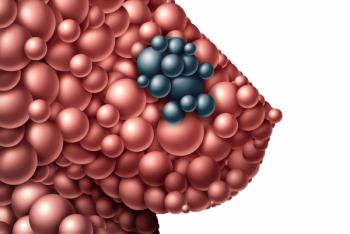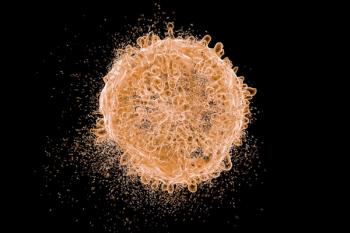
Oncology NEWS International
- Oncology NEWS International Vol 7 No 3
- Volume 7
- Issue 3
Immediate Reconstruction Safe After Previous Irradiation
SAN ANTONIO--Women who have locoregional cancer recurrence after breast-conserving surgery and radiation therapy can safely undergo immediate breast construction and use of a TRAM flap after mastectomy for the recurrent disease. However, the breast reconstruction procedure should include use of a free flap, which has a lower risk of necrosis and flap loss than pedicle flaps, Bonnie Baldwin, MD, said at the San Antonio Breast Cancer Symposium.
SAN ANTONIO--Women who have locoregional cancer recurrence after breast-conserving surgery and radiation therapy can safely undergo immediate breast construction and use of a TRAM flap after mastectomy for the recurrent disease. However, the breast reconstruction procedure should include use of a free flap, which has a lower risk of necrosis and flap loss than pedicle flaps, Bonnie Baldwin, MD, said at the San Antonio Breast Cancer Symposium.
The difference in outcome between free and pedicle flaps probably relates to inadequate vascularization in mastectomy-site beds in previously irradiated breasts, said Dr. Baldwin, a plastic surgeon at M.D. Anderson Cancer Center.
Dr. Baldwin and her colleagues compared outcomes of immediate reconstruction in two groups of women undergoing mastectomy: Those with locoregional recurrence after previous breast-conserving surgery and irradiation and those with previously untreated breast cancer. The breast conservation cohort included 48 breasts, 27 reconstructed with free TRAM flaps and 21 with pedicle flaps. Reconstruction outcomes were compared with those of 739 previously untreated breasts, 554 reconstructed with free flaps and 185 with pedicle flaps.
The overall complication rate did not differ significantly, 31% in the breast conservation group vs 25% in the previously untreated patients, Dr. Baldwin reported. No significant differences occurred with respect to flap necrosis, infection, fat necrosis, hematoma, or seroma.
The incidence of total flap loss also did not differ between the two groups: 0% in the breast conservation patients and 0.7% in the previously untreated patients. However, partial flap loss occurred significantly more often in the breast conservation group, 12.5% vs 1.6%.
Evaluation of partial flap loss in the breast conservation group showed that all six flap losses occurred in women who had reconstruction with pedicle flaps.
The findings show that immediate breast reconstruction with a TRAM flap can be performed safely in women who have a history of breast conservation and irradiation, Dr. Baldwin said. However, the higher incidence of partial flap loss associated with pedicle flaps supports the use of free TRAM flaps in these patients.
"We prefer to do breast reconstruction with TRAM flaps and skin-sparing mastectomy," Dr. Baldwin said. "We wanted to see if it would be possible to perform reconstruction with TRAM flaps in women who had prior breast-conserving surgery and irradiation. We were successful in that we had no total flap losses, but we did have more problems with partial flap necrosis in pedicle flaps."
The difference, she said, probably relates to the fact that "we were dealing with an irradiated bed. A free flap probably has a better blood supply, compared to a pedicle flap in previously irradiated breasts."
Articles in this issue
almost 28 years ago
ACS Takes Aim at Proposed Federal Tobacco Billsalmost 28 years ago
Loan Defaults Disqualify 1,402almost 28 years ago
FDA Gives OK to Seven New Cancer Drugs in 1997almost 28 years ago
HIA Chemo Promising in Colon Cancer Liver Metsalmost 28 years ago
Proposed Budget Spells ‘Good News’ for NCIalmost 28 years ago
Proposed Budget Has Extra Funds for FDA Teen Smoking Effortalmost 28 years ago
CRFA Awards 16 New Grants and Fellowshipsalmost 28 years ago
Cancer Pain Treatment Requires Clear Terminology About ‘Addiction’almost 28 years ago
‘Staging’ of the Managed Care Market Is Crucialalmost 28 years ago
NCI, EPA Attempt to Resolve Differences Over Childhood CancerNewsletter
Stay up to date on recent advances in the multidisciplinary approach to cancer.
































































































